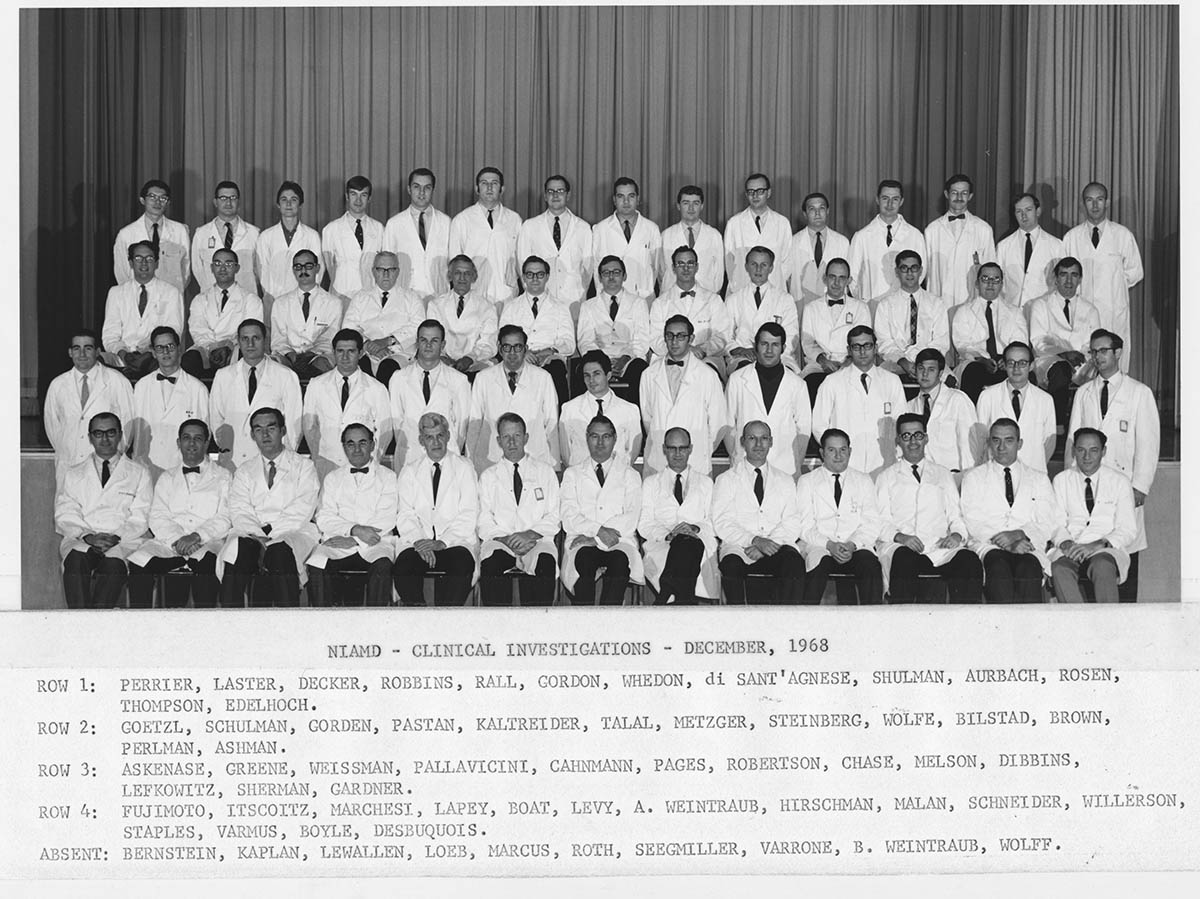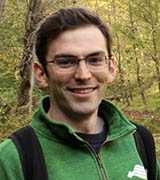From the Annals of NIH History
From Yellow Berets to Nobel Laureates
The Vietnam War and NIH’s Clinical Associates Program

CREDIT: OFFICE OF NIH HISTORY AND STETTEN MUSEUM
Clinical Investigators class photograph, National Institute of Arthritis and Metabolic Diseases: Michael Brown (row 2, third from right), Robert Lefkowitz (row 3, third from right), Harold Varmus (row 4, third from right), and Ira Pastan (row 2, fourth from left) are among the investigators present.
It may seem like a coincidence that Nobel laureates Michael Brown, Joseph Goldstein, Harold Varmus, and Robert Lefkowitz all started their training at NIH in the summer of 1968. But it wasn’t just happenstance according, to Raymond Greenberg, a professor of Public Health at the University of Texas Health Center at Houston (Houston) and author of Medal Winners: How the Vietnam War Launched Nobel Careers. In a virtual presentation he gave at NIH in November 2020, he highlighted how his book tells this overlooked story through the lives of those four men.
As the United States’ involvement in Vietnam escalated in the late 1960s, a doctor draft ensured an adequate supply of freshly trained physicians for the armed forces. “If you were a male physician, you were subject to a special draft for physicians,” said Greenberg during a virtual lecture he gave at NIH in November 2020. “Pretty much everyone was going to serve for some period of time.”
Not all of the drafted physicians served in the combat zone of Vietnam; some were posted to U.S. military hospitals around the world. But with public opinion of the war deteriorating, many physicians sought alternative types of public service to satisfy their draft obligation.
Yellow Berets
One such alternative was NIH’s Associate Training Program (ATP), a two-year research program under the Commissioned Corps of the United States Public Health Service. The small percentage of applicants admitted were known as clinical associates (CAs). The ATP had the pick of the best and brightest medical school graduates. After completing residency training, the successful applicants came to NIH where they performed clinical duties and conducted bench research in the lab of a senior scientist. The number of CAs in the ATP peaked around 200 per year at the height of the war, then fell precipitously after a peace treaty was signed in 1973.
Some people referred to the CAs as Yellow Berets. In contrast to the Green Berets, the United States Army Special Forces, the Yellow Beret label implied cowardice, possibly because supporters of the war effort viewed the CAs as trying to stay out of harm’s way.
The ATP proved to be an incredibly successful program, ultimately producing many of the top-notch physician–scientists of that generation. Compared with physicians who weren’t in the program during the Vietnam War, NIH CAs were more likely to go on to hold academic positions as professors, department chairs, and deans. In addition to Brown, Goldstein, Varmus, and Lefkowitz, six other physicians who were CAs during the war went on to receive Nobel prizes, too—J. Michael Bishop (1989), Alfred Gilman (1994), Stanley Prusiner (1997), Ferid Murad (1998), Richard Axel (2004), and Harvey Alter (2020). With such a cadre of distinguished alumni that also included National Institute of Allergy and Infectious Diseases Director Anthony Fauci, it’s not surprising that the designation of Yellow Beret eventually became a badge of honor.
Learning to Think Like Scientists
In the summer of 1968, Brown, Goldstein, Varmus, and Lefkowitz became CAs and joined NIH’s tight-knit, collaborative community of innovative scientists. The four attributed much of their later success to learning from their mentors, who taught them how to think like scientists.
Goldstein was the only one who had basic-research experience before coming to NIH. “If we think about our mythology about who goes on to be a great scientist and win Nobel Prizes, I think one of our preconceptions is that these people know from very early in life that this is the pathway that they’re on,” said Greenberg. None of the four future Nobel laureates had prior research experience or aspired to become serious scientists. The ATP proved to be a transformative experience, introducing them to bench science and launching their trailblazing research careers.
Brown worked in Earl Stadtman’s lab, where he studied the activation of glutamine synthetase, an enzyme involved in bacterial nitrogen metabolism. Goldstein worked in the lab of Marshall Nirenberg (who shared the Nobel Prize in 1968 for the “interpretation of the genetic code and its function in protein synthesis”) and studied how translation, the process of building protein chains, is terminated. Luckily, NIH had access to patients with rare diseases that most physicians outside of NIH had never seen before. In an event that sparked his curiosity and foreshadowed his lifelong partnership with Brown, Goldstein treated a girl with familial hypercholesterolemia, a condition that causes elevated concentrations of cholesterol in the blood and can lead to heart attacks in childhood. Already close friends, Brown and Goldstein both went to the University of Texas Southwestern (Dallas) after leaving NIH and together discovered that people with familial hypercholesterolemia have a defect in the receptor for low-density lipoprotein (unhealthy cholesterol). They won the Nobel prize in 1985 “for their discoveries concerning the regulation of cholesterol metabolism.” Their findings led to the subsequent development of cholesterol-lowering statin drugs.
Varmus joined Ira Pastan’s lab and studied how lactose metabolites and cyclic adenosine monophosphate triggers the transcription of genes involved in lactose metabolism. Varmus left NIH for the University of California at San Francisco (San Francisco), later receiving the Nobel prize with fellow former CA J. Michael Bishop in 1989 “for their discovery of the cellular origin of retroviral oncogenes” that demonstrated how retroviruses can trigger proto-oncogenes to push a cell into a cancerous state. Varmus later returned to NIH, serving as director (1993–1999), then president and CEO of Memorial Sloan-Kettering Cancer Center in New York (2000–2010), and later rejoining NIH again as director of the National Cancer Institute (2010–2015).
Lefkowitz also worked with Pastan as well as with Jesse Roth. At first, Lefkowitz experienced repeated failures in the lab and, in frustration, planned to leave research altogether. But in the process of labeling the adrenocorticotropic hormone with radioactive isotope of iodine, and later demonstrating that the hormone attached to the membrane of adrenal-gland cells, Lefkowitz found his passion for science. He later joined Duke University (Durham, North Carolina), ultimately receiving the Nobel Prize in Chemistry with his former trainee Brian Kobilka in 2012 for their work characterizing adrenaline receptors and the structure of G-protein coupled receptors. (See excerpt from Lefkowitz’s book in this issue of the NIH Catalyst at https://irp.nih.gov/catalyst/v29i2/from-the-annals-of-nih-history-lefkowitz.)
The four Nobel laureates are still active in the scientific community: Brown and Goldstein hold endowed professorships at the University of Texas Southwestern Medical Center; Varmus holds a named professorship at Weill Cornell Medical College (New York); and Lefkowitz is a distinguished professor at Duke University and an investigator with the Howard Hughes Medical Institute.
To watch a videocast of Raymond Greenberg’s virtual lecture “Medal Winners: How the Vietnam War Launched Nobel Careers,” presented on November 12, 2020, at NIH, go to https://videocast.nih.gov/watch=38976. For a complete list of NIH Nobel laureates including those who trained or worked extensively in one of NIH’s intramural laboratories, visit https://irp.nih.gov/about-us/honors/nobel-prize.

Ethan Smith is a postbaccalaureate fellow in the National Institute of Nursing Research. He is working on clinical studies involving biomarkers for traumatic brain injury. Outside of work he enjoys playing board games with friends, reading, and watching television.
This page was last updated on Tuesday, February 15, 2022
